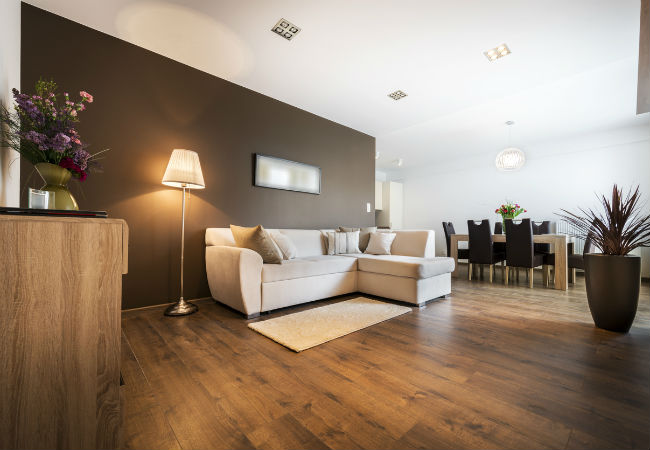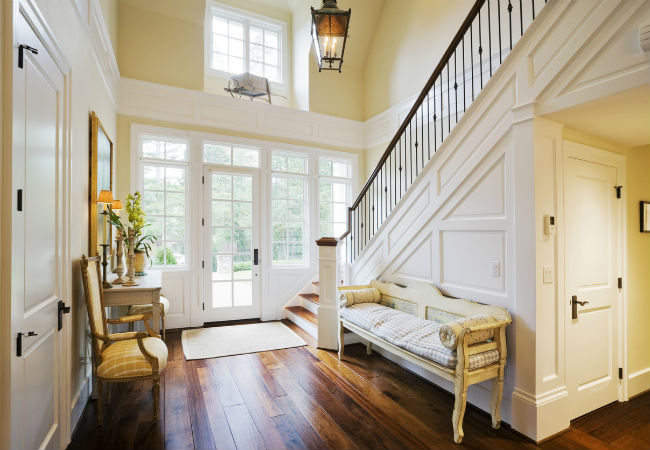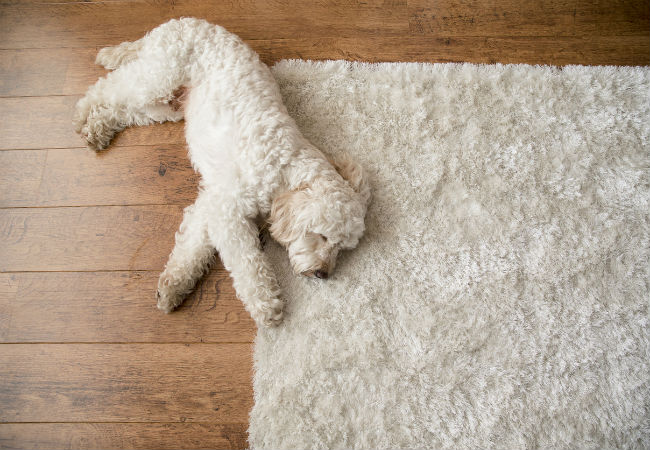We may earn revenue from the products available on this page and participate in affiliate programs. Learn More ›
You finally decided on the perfect hardwood for your floors—whether that’s a deep, rich walnut, a warm cherry wood, or a rustic oak. While there are many species of hardwood fit for flooring, each with its own look and own beauty, they all share one thing in common: They need a protective finish to keep them looking their best.
Choosing the right top coat for newly installed wood floors or refinishing boards that are a little worse for the wear, however, can be a little intimidating. Hardwood floor finishes have varying levels of ease, durability, even glossiness—one of the most important aesthetic considerations after choosing your preferred wood. Make your decision a little easier by brushing up on the basics of the eight most popular types of hardwood floor finishes, all outlined below.

Carpet, hardwood, vinyl, and tile flooring.
Bob Vila has partnered with Empire Today to help you easily get beautiful new floors at a great price.
Free In-Home Estimates
1. Water-Based Polyurethane
Best for: Floors in need of a clear finish that dries quickly
Pros: Easy application and cleanup; low odor and low VOCs; very smooth and shiny finish; no yellowing
Cons: High-gloss water-based polyurethane magnifies every scratch and scrape
Top Picks: In our Buyer’s Guide on the best water-based polyurethane finishes, General Finishes’ High-Performance Water Based Top Coat and Bona’s Mega Wood Floor Finish were two of the top performers.
Although water-based polyurethane sometimes looks a little milky in the can, it dries clear and resists yellowing over time. While most homeowners prefer to apply water-based polyurethane sealer with a high gloss, you’ll also find satin and semi-gloss options. Made with synthetic resins and plasticizers, water-based polyurethane is a very durable finish that resists moisture fairly well (although you’ll still want to mop up any spills or leaks ASAP). Otherwise, it’s easy to care for hardwood floors with this finish—a broom and a damp mop is generally all you’ll need. Never wax polyurethaned floors, as that can dull the finish.
These are just a few of the qualities that make water-based polyurethane one of the most popular hardwood floor finishes for the home. Water-based polyurethane also scores high in the environmentally friendly category, releasing far fewer volatile organic compounds (VOCs) than many of the other options. It has little odor during application, which is a big benefit if you plan on finishing the floors yourself. It dries quickly, too: You’ll typically only need to wait two to four hours between coats (three to four coats total is the usual recommendation). After that, you’ll be able to walk on your new floors within a few hours, although you should wait at least 48 hours before moving all furniture back into place.

2. Oil-Based Polyurethane
Best for: High-traffic areas
Pros: Not too expensive; very durable; resists moisture; easy to maintain
Cons: Slow drying; releases a lot of VOCs; flammable; yellows over time
Top Picks: Dura Seal Polyurethane for Wood Floors, Rust-Oleum Varathane Oil-Based Floor Finish, and Minwax Super Fast Drying Polyurethane for Floors are all quality selections.
Oil-based polyurethane consists of linseed oil, synthetic resins, and plasticizers. Its strength and durability make it a popular finish for commercial properties, but many homeowners like to use it in high traffic areas inside the house, as well. Luckily, those same hardwearing characteristics mean you won’t have to refinish the floors as often as with some of the other options. And it’s easy to maintain—just sweep or vacuum regularly, and clean away dirt with a damp sponge.
Oil-based polyurethane has a slight amber or yellowish tint and can yellow even more over time, which adds a bit of rich, warm, amber color to the floors if that’s your goal. You’ll find it in high-gloss, semi-gloss, and satin sheens.
This finish has a very strong odor and releases a high level of VOCs, so you’ll need to don a respirator to protect your lungs if you plan on finishing the floors yourself. You’ll also need to allow quite a bit more time for the project than with water-based polyurethane and clean up with mineral spirits rather than soap and water. Generally, it takes eight to 10 hours for each coat to dry (two to three coats total is the usual recommendation). After the last, you’ll need to wait at least 48 hours before walking on the floors in shoes and four days to fill the rooms with furniture once more.
3. Moisture-Cure Urethane
Best for: Situations requiring the toughest floor finish
Pros: Extremely durable
Cons: Very high VOCs; difficult to apply
Top Picks: hough most DIYers won’t be shopping for this product themselves because it’s typically used only by professionals, your pro may use products from reputable brands such as Dunham’s or Lenmar.
Originally created for use in bowling alleys, moisture-cure urethane is extremely tough and durable after it dries to a very high shine. It resists moisture, scratches, stains, and general wear. Its difficult application makes it less of an option for a do-it-yourselfer, though. Plus, the very high level of VOCs it releases can linger in the air for weeks, so all household members will need to relocate for as long as two weeks after application.
As the name might suggest, moisture-cure urethane draws moisture from the air to cure, which means that it’s affected by the humidity on the day of application. If the air is very dry, the finish won’t cure or dry evenly. Too humid, and it can start to dry before it’s spread evenly across the floor. An even application of this fickle finish requires a quick hand and an experienced touch.
Because of the many downsides of the finish, moisture-cure urethane is mostly used in commercial settings such as bowling alleys, dance halls, and restaurants—all places where its resistance to wear and moisture, high-gloss appearance, and strength outweigh its downsides.

4. Wax
Best for: Anywhere you want a low-sheen finish
Pros: Easy to apply and touch up; little odor or VOCs; penetrates into wood and can be combined with stain; dries quickly and can be walked on within hours of application
Cons: Application is labor-intensive; not very durable; yellows or darkens over time
Top Picks: Holloway House Pure Floor Wax and Lundmark All Wax are both high-quality choices.
Prior to the development of polyurethane finishes in the 1960s, wax was the hardwood floor finish of choice and had been so for hundreds of years. Even today, it’s still a popular option for historic homes and is also frequently chosen by do-it-yourselfers who like its low-sheen, natural appearance. You’ll find liquid and paste wax; both require several coats that are buffed in by hand, but liquid wax is usually applied with a wool applicator while paste wax is applied with a rag. You can even mix wood stain in with the wax to color your floors while you finish them.
On the flip side, waxing hardwood floors doesn’t create a very durable finish. Exposure to water can create white marks, so wax isn’t the best floor finish for bathrooms or kitchens. It’ll scuff and scratch, too, though these are fairly easy to buff away and hide under another coat of wax.
Be aware that wax sometimes yellows or darkens over time, so it’s best used over wood that already has a warm cast. And if you decide you want to replace your wax finish with polyurethane, you’ll need to completely strip the wax from the floor.
5. Shellac
Best for: Floors where you want a natural product that doesn’t emit a lot of VOCs and dries quickly
Pros: Natural, sustainable product; easy to repair or touch up; adheres well to oily tropical woods
Cons: Very flammable; not easy to apply evenly; far less durable than many other options; needs to be freshly mixed before application
Top Pick: Zinsser’s Bulls Eye Clear Shellac is a quality shellac for floors.
Made from denatured alcohol mixed with secretions of the lac bug, an insect found in Asia, shellac has been used to seal and finish wood for hundreds of years. Shellac naturally dries to with an orange tint and high-gloss finish, although it can be bleached or tinted as well as mixed with extra denatured alcohol to create a more matte surface. Because shellac dries quickly, it can be difficult to apply without leaving visible lap lines.
This particular hardwood floor finish also tends to stain and water spot, and it’s vulnerable to damage from alcohol and ammonia. It doesn’t hold up to foot traffic nearly as well as polyurethane, but touching it up is fairly easy; just buff in a new coat of shellac when necessary.
While you can buff wax over shellac, you cannot apply one of the polyurethane finishes over it, so if you decide to change your floor’s finish, you’ll need to completely strip away the shellac first.

6. Penetrating Oil Sealer
Best for: Creating a low-shine finish that highlights the grain of the wood.
Pros: Natural product; fairly easy to apply; brings out wood’s beauty
Cons: Not very durable; requires recoating every couple of years; expensive
Top Picks: Both Bona Craft Oil 2K and WOCA Denmark Penetrating Oil will deliver top-quality results.
Very popular prior to the introduction of polyurethane floor sealers in the 1960s, penetrating oil sealers aren’t used much today but are still favored by some homeowners who love the way that oil brings out wood’s grain, beauty, and depth without adding high shine or gloss. It’s also a great choice if you are restoring a historic home.
Penetrating oils—there are several types, but tung oil is the most common—soak into the wood’s pores, helping prevent scratches and other damage. Unlike most other hardwood floor finishes, penetrating oils don’t leave a hard “shell” on top of the wood; for this reason, a final coat of wax often tops the oil for extra protection.
While penetrating oil sealers give wood a naturally lovely appearance, they don’t hold up well to foot traffic, so be prepared to re-oil your floors every three to five years if you choose this option. You should also be aware that water and chemicals can spot or damage oil-sealed floors, so you’ll need to use wood floor cleaners specifically formulated for this type of finish. If your hardwood floors get a scratch, it’s an easy job to touch them up, though; just buff more oil into the damaged spot.
Penetrating oils generally dry very slowly—often requiring an entire day between coats—so this isn’t a quick do-it-yourself project.
7. Acid-Cured Finish
Best for: Exotic wood floors or those with elaborate patterns, such as parquet flooring
Pros: Extremely durable; dries quickly
Cons: Very high VOCs; highly flammable; expensive; pro-only application
Top Picks: Though DIYers likely won’t be shopping for these products themselves, their pros will likely use a conversion finish from Glitsa, Synteko, or Mohawk.
The crème de la crème of hardwood floor finishes, acid-cured finish (also called Swedish finish or conversion finish) is even more durable than the polyurethanes. It has an alcohol base and uses acid for the curing process, creating a shiny finish that is extremely durable and resistant to chemical damage, scratches, and scuffs. Still, the finish highlights the wood’s grain, color, and natural beauty.
Before you select it for its resilience, know that acid-cured finishes release very high levels of VOCs and have a very strong odor. In the event that you apply it, you, your family, and your pets will need to stay elsewhere for several days while the floors cure. It also requires excellent ventilation during application, along with a full-face respirator. Once applied, it’s not easy to touch up or refinish an acid-cured floor, but you shouldn’t be troubled with damage or wear under most normal circumstances thanks to its durability.
8. Aluminum Oxide
Best for: High-traffic areas or anywhere you want supreme protection from wear and tear
Pros: The hardest, most long-lasting type of finish; low maintenance; available in several levels of glossiness
Cons: Difficult to touch up or refinish; only available on prefinished wood planks
Aluminum oxide is a naturally occurring mineral that provides an extremely long-lasting protective coating on hardwood floors. It protects the floor from scratches, fading, water damage, scuffs, and general wear and tear without changing the color of the wood or hiding its grain. Available in several levels of shine, it can go on as matte or as shiny as you’d like. You won’t apply this yourself, though; aluminum oxide is only available as an option on prefinished flooring planks.
On the downside, it’s not easy to remove or restore the aluminum oxide finish if there comes a time that you eventually want to touch up damage or switch to a different finish. You’ll need to call in pros to tackle the job, possibly even replace the floorboards. Still, if you want the most durable hardwood floor finish—it can last up to 25 years—that’s also low maintenance and you like the idea of installing wood flooring that’s already finished and ready to go, aluminum oxide is a good choice.

